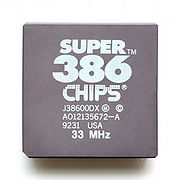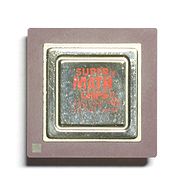- Chips and Technologies
-
Chips and Technologies (C&T) was the first fabless semiconductor company, a model developed by its founder Gordon Campbell. Founded by Dado Banatao.
Its first product was an EGA IBM compatible graphics chip. This was followed by chipsets for PC motherboards and other computer graphics chips.
C&T was acquired by Intel in 1997, primarily for its graphics chip business.
Contents
x86 products
C&T SuperMath J38700DX was a 80387DX compatible FPU coprocessor.
C&T also designed a 386-compatible microprocessor known as the Super386 38600DX/38600SX using clean room design techniques, but this chip never enjoyed as much success as the 386 CPUs produced by Intel, AMD, and Cyrix. C&T 38605DX had 512 byte cache, but the 144 pin PGA package was incompatible with 386 socket.
Chipsets
Single chip solutions
- 82C100 - IBM PS/2 Model 30 and Super XT Compatible Chip[1] - Released in 1987,[2] compatible with 8086, 80C86, V30, 8088, 80C88, V20 CPUs. Compatible with all PC/XT functional units: 8284, 8288, 8237, 8259, 8254, 8255, DRAM control, SRAM control, Keyboard control, Parity Generation and Configuration registers. Additionally features EMS control, dual clock and power management. It supports up to 2.5 MB RAM.
- 82C235 - Single Chip AT (SCAT)[3] - Released in 1989,[4] compatible with PC/AT. Supported LIM EMS 4.0, up to 16 MB memory and Shadow RAM.
- 82C836 - Single Chip 386sx AT (SCATsx)[5] - Compatible with PC/AT (bus), supported all the features of SCAT, added support for the i386SX processor and i387SX math coprocessor.
Video chips
Chips and Technologies was the first company (outside of IBM) to deliver a compatible VGA chipset, the 82C451, and VGA cards were introduced the same year as VGA(1987) based on the 82C441 [2], opening up the IBM compatible graphics display market. This market was then entered by companies such as Trident Microsystems, Western Digital, Cirrus Logic, Oak Technologies, and others, until it was saturated.
Chips and Technologies provided the Wingine video card, a very high speed framebuffer that sat in a proprietary local bus slot on supported motherboards. Epson and JCIS were two manufacturers who offered motherboards featuring the Wingine local bus slot. The Wingine was popular with users of NEXTSTEP for Intel processors, as it was one of the highest performing video cards supported by the operating system.[6]
C&T eventually ended up competing in the low end of the video market, the 65555 featured an LVDS transmitter and notably won a design in early Compaq Armada laptops.
See also
References
- ^ 82C100 IBM PS/2 Model 30 and Super XT Compatible Chip. Chips and Technologies.
- ^ "Firm Says System Logic Chip Will Speed PS/2 Model 30 Cloning". InfoWorld: p. 26. 1987-07-27. http://books.google.pl/books?id=6DsEAAAAMBAJ.
- ^ 82C235 Single Chip AT. Chips and Technologies.
- ^ "Chip Makes Cheaper AT Clones possible". InfoWorld: p. 1. 1989-10-09. http://books.google.pl/books?id=pjAEAAAAMBAJ.
- ^ 82C836 Single Chip 386sx AT. Chips and Technologies.
- ^ [1]
External links
Categories:- Defunct computer companies of the United States
- Defunct computer hardware companies
- Defunct semiconductor companies
- Fabless semiconductor companies
Wikimedia Foundation. 2010.




